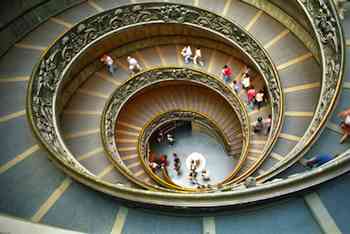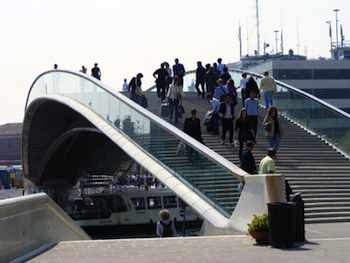- MENU
- HOME
- SEARCH
- WORLD
- MAIN
- AFRICA
- ASIA
- BALKANS
- EUROPE
- LATIN AMERICA
- MIDDLE EAST
- United Kingdom
- United States
- Argentina
- Australia
- Austria
- Benelux
- Brazil
- Canada
- China
- France
- Germany
- Greece
- Hungary
- India
- Indonesia
- Ireland
- Israel
- Italy
- Japan
- Korea
- Mexico
- New Zealand
- Pakistan
- Philippines
- Poland
- Russia
- South Africa
- Spain
- Taiwan
- Turkey
- USA
- BUSINESS
- WEALTH
- STOCKS
- TECH
- HEALTH
- LIFESTYLE
- ENTERTAINMENT
- SPORTS
- RSS
- iHaveNet.com: Travel
By Rick Steves

Vatican Musuem
Rome and Venice are two of my favorite cities.
But to enjoy these classic destinations fully, you need to be prepared for changes in 2010. Knowing about a few recent developments will make your visit smoother this year.
Rome may be the "Eternal City" but that doesn't mean it has stopped evolving.
There's a new taxi scam in Rome (actually, that's nothing new). A recent law limits the taxi fare from the airport into town to 40 euros (about $56). Yet some cabs post an "official 60-euro rate" sign for the same trip. These cabbies are taking advantage of a loophole. The 40-euro fare is for Rome cabs -- taxis based outside of Rome get a break because they need to drive out of the city again. At least it's easy to beat this scam. When leaving the airport, choose a Rome city cab (look for "SPQR" on the door), and you'll save around $28.
Another new regulation will impact many budget travelers -- Rome's official ban on picnicking at historic monuments. While it probably won't be too strictly enforced, one place you're likely to be fined for picnicking is on the Spanish Steps. You should be OK if you eat with a view rather than on the view.
To the south of Rome, Pompeii still offers the best look at first-century A.D. Roman life. The long-closed
Venice is crowded, expensive, and confusing. If you keep up-to-date on this city, you find it's still the same ... just less so. The famous and much photographed Bridge of Sighs, which connects two wings of the Doge's Palace over a canal, is surrounded by scaffolding -- and will be for the next few years -- due to restoration. In past years, Venetian scaffolding was masked with beautiful murals to disguise the construction work. Now, thanks to our more cash-strapped age, most of Venice's scaffolding is covered with advertising.
Despite the economic downturn, there's one new price break. Venice's city museums now offer youth and senior discounts to Americans and others who aren't citizens of the
Venice's top art museum, the Accademia, is still being expanded and renovated. In 2010, expect some rooms to be closed for construction, and many of its paintings displayed in different rooms. The 17th-century Customs House at the end of the Grand Canal recently became the home of the new Punta della

Calatrava Bridge, Venice
This year, you can expect more controversy over Venice's Calatrava Bridge, a.k.a. Constitution Bridge, which spans the Grand Canal from the train station to Piazzale Roma. The bridge, designed by Spanish architect Santiago Calatrava, opened in 2008 after delays, cost overruns, and questions about its stability. Its modern design is a sore point for a city with such rich medieval and Renaissance architecture. Adding fuel to the controversy, the sleek form does not allow for wheelchair access, and critics question whether the bridge adequately serves the daily hordes of tourists. Dozens of visitors have twisted their ankles due to its irregular steps and its mix of glass and stone flooring.
As more travelers get smart about flying into smaller airports, Venice's Marco Polo Airport is getting more use. And, along with boats and city buses, now there's one more way to connect Venice with its airport on the far side of the lagoon: a private shuttle service that charges about $70 per minivan (seats up to eight, www.trevisocarservice.com). Also, a new minibus service links Venice's Marco Polo and Treviso airports with the nearby city of Padua (www.airservicepadova.it).
No matter how you get here -- and no matter what's been changed -- Venice's elegant canal-strewn charm and Rome's "bella" lifestyle will always be waiting for you. "Buon viaggio!"
© Rick Steves Distributed by Tribune Media Services, Inc.
AUTOS | HOBBIES | EDUCATION | FAMILY | FASHION | FOOD & RECIPES | HOME DECOR | RELATIONSHIPS | PARENTING | PETS | TRAVEL | WOMEN
Vacation Travel - What's New in Rome and Venice in 2010